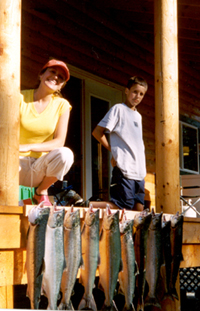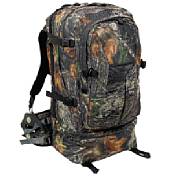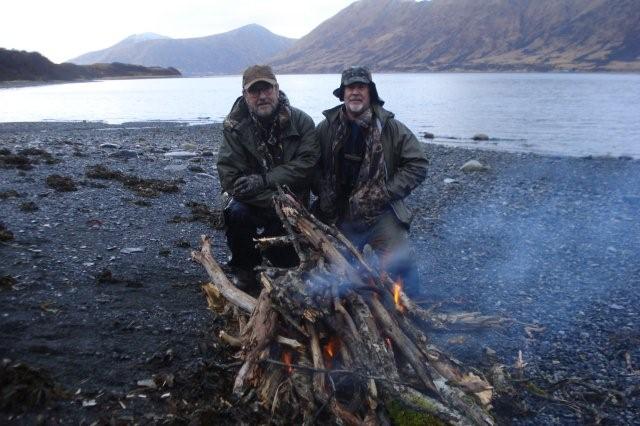|
s-u-r-v-i-v-e.com
The definitive guide
to your personal survival.
|

An Alaska "Go To" cabin
has resources not available
in the city. |
|
Emergency Food Supplies
& Survival Food Storage
This website offers emergency food procurement tips and options for food storage to help you with your survival preparedness including suggested prepackaged food supplies, garden and seed suggestions as well as food storage recipes.
Having enough stored food and water during an emergency can literally mean the difference between survival and not. In the short term, you can prepare for the unexpected by purchasing and storing nonperishable food items, properly preserving perishable food, and using empty beverage containers to store water in your garage or basement. Stock your emergency food supply to feed your family and perhaps a little extra as "trade goods".
In the longer term for fresher tasting foods, you will need to consider either growing your own food in a garden and/or obtaining necessary protein through subsistence hunting and fishing. Accordingly, you should properly store an appropriate variety of seeds for your area as well as have on hand fishing equipment and hunting firearms, which can also double for self-defense of your home if necessary.

An NRA friend of mine likes to say "...the currency of the future will be ammo." He may be partially right, although I'd add food, gasoline, toilet paper and alcoholic beverages as additional substitutes for currency of the realm in a disaster situation.
|

Water. Your first priority in any emergency situation is to make sure you have enough water on hand for you and all of your family members. You should store at least one gallon of water per person per day in a cool dark place. In addition to whatever you have prepositioned in plastic containers it's adviseable to fill up your bathtub and sinks with water before the water system breaks or becomes contaminated.
Food Storage. Many years ago the Farmer's Almanac advised it's readers to keep a years supply of food on hand in case of emergencies. It was good advise back then and it's good advise today and easier to accomplish. Freeze dried food in vacuum sealed packaging is readily available from a wide variety of excellant companies and they have a very long shelf life. Properly dry-packed foods can have a very long shelf life according to the Mormon church's Provident Living website. For example, dry packed white rice, pinto beans, and sugar under the best conditions can be safely stored for 30+ years. Commercial dry packing for long term storage is usually done in #10 long term food storage cans or by do it yourselfers in sealed mylar bags with oxygen absorbers inside of polly buckets.
Warning: Botulism poisoning may result if moist products are stored in packaging that reduces oxygen. When stored in airtight containers with oxygen absorbers, products must be dry (about 10% or less moisture content).
Dry products that are not suitable for longer-term storage due to moisture content, oils, or other concerns include:
Barley, pearled
|
Meat, dried (such as jerky) |
Eggs, dried |
Nuts |
Flour, whole wheat |
Rice, brown |
Grains, milled (other than rolled oats) |
Sugar, brown |
Granola |
Vegetables and fruits, dehydrated (unless dry enough, inside and out, to snap when bent) |
Sealed water proof polly buckets of rice, beans, powdered milk, grains, cereals, sugar and seeds can have a long shelf life and can be purchased commercially or prepared at home. For more perishable foods and as another option, traditional food preservation techniques such as home canning, smoking, dehydrating, freezing and pickling should be considered for intermediate term food storage.


Procure this large package of survival food yourself at:
www.AlaskaOutdoors.com

The best basic survival foods for long term storage are:
1. Rice (white)
2. Beans (dry)
3. Salt
4. Sugar / honey
5. Rolled oats
6. Pasta
7. Non-fat Dehydrated milk
8. Coffee or tea (vacuum sealed tins)
9. Vitamin tablets (particularly vitamin C)
10. Baking soda (properly packaged)
11. Yeast (properly packaged)
12. Wheat
13. Potato flakes
14. Seeds for your garden (non-hybrid or heirloom)
Note: For long term reliable food supplies you should of course plan for a garden and growing your own. It is important to know that storage of seeds from many hybrids and other cultivated plant varieties sold in stores is not a good idea as their second generation seeds can't be repropaged in subsequent years. If they do produce viable seed, the resulting plants are usually inferior to the parent plant. Accordingly, we recomment purchasing open-pollinated, non-hybridized seeds or heirloom seeds for storage.

Summary Checklist of survival items for your home are:
1. Water
2. Heat - oil, gas, propane, coal or wood supplies as appropriate
3. Electricity - at least minimal for running furnace, some light, refrigeration, and charging cell phones, etc., - from generator, batteries or solar
4. First Aid supplies
5. Basic tools
6. Food
7. Self defense weapons (guns and ammo)
8. Sanitation: Toilet paper / soap & detergent

For information about
advertising in
S-U-R-V-I-V-E.com
please Contact Us
Established
1996
Alaska Internet Marketing, Inc.
Hosting-Design-Advertising Links
Anchorage, Alaska
(907) 248 -5662
info@alaskaoutdoors.com
|
|
Be prepared - if possible buy a cabin away from urban areas where survival will be easier! |
For information about
purchasing survival and other outdoor gear, see our camping equipment webpage. |

Survival Go ( Bug Out ) Bag
|
